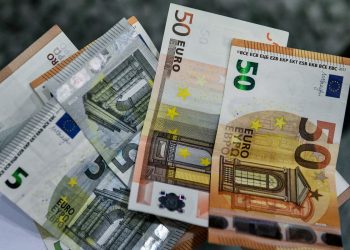Where did the investigation lead us:
– Interview Giorgos Lechouritis (INKA): Tricks with scoops, weight, packaging, initial pricing – “Another price on the shelf, another on the counter”
– What is a “price correction” in supermarkets – On fresh products the badges change three times a day
– Serious complaints against the government by the butchers’ president to the Data Journalists – He speaks of ‘low blows’
– Turnover per supermarket chain – In 2021 reached a total of 10.1 billion euros, equal to 1/20th of Greek GDP – The rally continues in 2022, at +31% sales from 2016
by Vasilis Galoupis, Paris Karvounopoulos, Panos Katsahnias, Vagelis Triantis
Inflation, supermarket bills, energy bills, the war in Ukraine, strong dollar. Consumers are under siege on all fronts.
The non-humans, who make up the majority, are the ones most affected by the supermarkets. For years, food companies and supermarkets have been raising prices in small steps, worrying that large increases would frighten consumers. Other tricks were to quietly reduce the sizes of products instead of increasing prices.
The Data Journalists investigated why the increases “hit” Greek society to such an extent. The ‘household basket’ turns out to be a good trick for everyone to pluck a leaf and lose the tree. The first part of our research is being published today.
In the official language used by supermarkets, the price change procedure is called the ‘Price Correction’.
Prices change every day, but not in all the products they sell. There are specific product categories in each case, where depending on competition, supply and demand, each supermarket segment makes the decision to change prices. They change once a day. One day many codes can be changed, and the next day there may be fewer.
Thus, the “correction of prices” once a day, not only concerns food, but all products and by category: In milk for example at 200 codes will change 5 today, the next day can change another 5, and the day after tomorrow another 5. The same applies to food, the same for personal hygiene products, the same for detergents, the same for cosmetics, fresh products, and all standard products.
There were periods in the past when product prices could also be lowered if conditions dictated this. Now at 90%, the prices of products are constantly rising.
Giorgos Lechouritis, President of the Consumer Institute, answers the Data Journalist’s legitimate question on the tricks of supermarkets with specific examples.
As Lechouritis says:
“Supermarkets initially price at a high price, but at the end of the year or every month there are “refunds”. They normally price to put the profit on the product, and then the industry starts and makes the discounts depending on the consumption of the product. The auditor must see the credit invoices.”
“There’s another price on the shelf, another price on the counter. It is the most basic trick.”
“There’s a game going on with the scoops and the weight. The consumer cannot remember scoops in detergents or how many sheets a package has in stationery.”
“The other scam is that they are playing with the issue of packaging. There are smaller quantities in the same packs. An old detergent may have had 90 scoops, while now with the same packaging and size they are in box 70”.
“A game is played by reducing the weight of the packages. Where I used to buy 500 grams and pay 5 euros, today I buy 450 grams and pay 6 euros. The same applies to yogurts, margarine, tomatoes, bread, etc.”
At the end of November, as every year at this time, the official financial data were presented in the annual “Panorama of Greek Supermarkets 2022”.
The turnover of supermarkets for 2021 reached a total of 10.1 billion euros, equivalent to 1/20th of the Greek GDP! It increased by 2.4% compared to 2020 and by 9.5% compared to the last pre-pandemic year (2019).
As the survey finds, it was the 5th consecutive positive year, with sales since 2016 having jumped by 31% in total. The four most powerful supermarket chains, controlling 80% of the market with a total turnover of 8.2 billion. – out of 10.1 billion of the total pie -, it was for 2021:
Greek Sklavenitis Supermarkets: Annual sales of €3.99 billion (+5.1% compared to 2020)
Alpha Beta Vassilopoulos: EUR 1.97 billion (-2.7%)
Metro: EUR 1.37 billion (+2.7%)
Masoutis: EUR 883 million (+0.11%).
Last summer, inflation was bringing households in Greece to their knees. But not the supermarkets, which from June to August, due to tourism, recorded unprecedented turnover.
During this period, food inflation was above 12.6%. The prices of products on shelves were “galloping” at rates above 10% compared to the summer of 2021. The turnover of supermarkets soared by 11%, according to data from the research company IRI.
The biggest price increases from the beginning of the year until September were recorded:
In cooking materials (10.8%).
Personal hygiene products (10.5%)
In dairy products (9.3%).
 Savvas Kesidis, president of the Panhellenic Federation of Butcher Shopkeepers, explained to the Data Journalists the obstacles that the meat market encountered with the approximately 15-20,000 butchers across the country for the “Household Basket”, referring to “low blows”.
Savvas Kesidis, president of the Panhellenic Federation of Butcher Shopkeepers, explained to the Data Journalists the obstacles that the meat market encountered with the approximately 15-20,000 butchers across the country for the “Household Basket”, referring to “low blows”.
He told us, inter alia, that:
“In our effort to get us butchers into such a “Basket”, we encountered initial obstacles. The first obstacle was that the Act said that it must be businesses with a turnover of more than 90 million euros per year, so a district butcher’s shop could not join, like a large chain that is concentrated in its turnover and is not like a single retail business.”
“If we talk about December 21 to December 22, having the Russian-Ukrainian war in the middle, which typically triggered the rise in prices and the outbreak of inflation, as another “icing on the cake”, since everything had started a little earlier, I dare to say that right now in the beef we have a 20% to 25% increase compared to last year, in pork we have about 15% marginally to 20% in some special cases, in chicken 10% to 15%, in turkey a small increase of 3% to 5% is recorded and we have the same prices in lamb and goat”.








Discussion about this post